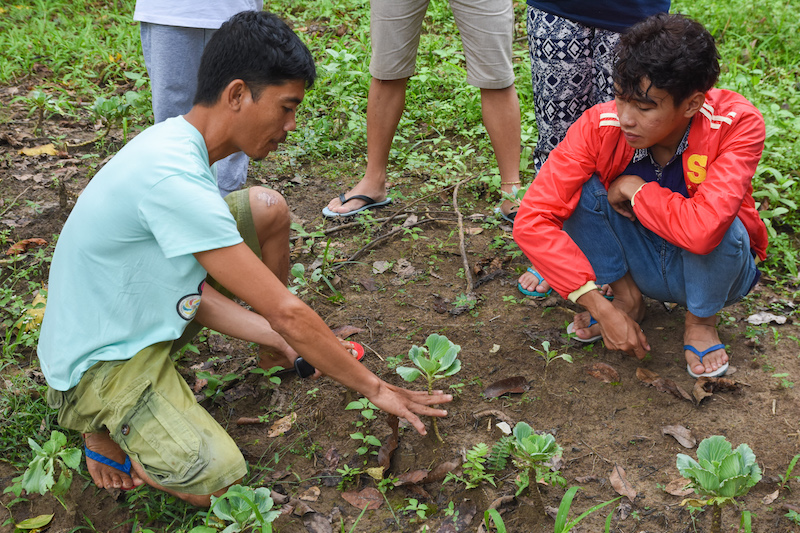Nabunturan, Compostela Valley.
I’d never guess that thin and big-eyed Bobong, father of three, achieved an extraordinary feat. He went from having no goals in life and binge drinking to saving a mountain. In one year.
Bobong is surrounded in a semi-circle by all twenty Creating Sinag Within volunteers. We sit around him, pen and paper in hand, taking down as much as we can get from what he shares with us: the steps of mixing soil, making compost, making foliar fertilizers, among others. I am fascinated by the way he speaks from experience (and from the heart). He talks about making plants healthier by mixing together old rice, sugar, and bits of fruits or vegetables and leaving this concoction to brew several days. It’s transformed into a gooey liquid that is harvested and sprayed onto the vegetables to make them grow healthier — NO pesticides needed! This organic farmer’s knowledge and skills are crucial to our goal of helping the survivors of the Marawi siege who are waiting to go home from their evacuation centers. With Bobong’s help, we hope to provide the survivors an alternative solution to the government’s canned food they receive as relief but which has been found to cause urinary tract infection among other things.
The change in Bobong since learning about organic farming has been striking, he admits sheepishly. As a farmer using chemical fertilizers before, his main interest was to cultivate fast-growing crops so he could cash them in and use the money to drink with his buddies. He would use pesticides on his crops but keep a small plot free of pesticides for his family’s daily consumption.
 Bobong explains how plants grow best in his experience. Photo by Louise Far
Bobong explains how plants grow best in his experience. Photo by Louise Far
A motorbike accident led him to recuperate on a mountain owned by a doctor who taught him organic farming. The more he learned and practiced organic farming, the more Bobong’s outlook on life changed. When he went full time into organic farming, he stopped fooling his buyers because it was the humane thing to do. He realized profit isn’t everything and made this his advocacy, becoming a model organic farmer who balances earning a living and healing the earth. From a very shy guy, Bobong is now a confident speaker and regularly trains people in organic farming. “Pesticides deaden the earth and a plant’s life force while organic farming nurtures this life force,”Bobong explains his change of heart.
“We want to eat organic but there’s none available where we live. Where can we buy organic food?”We ask him. “Grow your own food,”is Bobong’s consistent response.
We take a break and step out into the garden where Bobong gives us the grand tour pointing out that the okra in sandy soil grow much better than the okra in clayish soil. “You’ve got to know what kind of soil plants like,”he says. “If unsure, make it your default to not start planting without mixing clay, sand, and topsoil first.”He shares some more useful tips about making a seed bed versus making a seed bag and shows us the different roots that develop. He encourages us to talk to the plants and says, “Speaking circulates the air around the plants and feeds them carbon dioxide. Let the plants feel your intentions.”
We return to the room where Bobong has placed clay pots and big pieces of bamboo. Into them we pour several kilos of leftover cold rice, brown sugar, and fruits/plants that we’ve cut up. We mix them and cover the containers to be opened several days later when they’ve fully transformed by enzymes into organic concoctions which we can spray on soil and vegetables to make them grow big and healthy.
Two weeks later at the evacuation centers, we find that the problem isn’t that simple. Though evacuees have been growing vegetables around the evacuation centers, they need more land to cultivate crops and feed everyone. There are donated seeds and gardening materials, but no land to till. I see plenty of unused land around the evacuation centers. “Can’t these be used?”I ask the camp managers.“No,”is their ready response. “Because most of the land are privately owned. Evacuees can only farm on government land, and there are not many of these.”
I marvel at this logic and wonder how other nations would creatively approach the land challenge. I bet they would ask residents to give up a part of their lands for evacuees to till. Or perhaps start a container gardening program. That’s what I would do. Because everything grows like magic in our region of the Philippines – Mindanao – where the soil is rich, the rains are plentiful, and the sun shines brightly. It’s high time to stop giving away unhealthy canned foods and start capacitating evacuees to farm nutritious fruits and vegetables instead – beginning with providing them land, tools and seeds. This is our chance to go organic massively and inspire the rest of the world!
(Creating Sinag Within’s Mission 1 in August 2017 and Mission 2 in October 2017 trained volunteers in, among other things, organic farming, specifically in compositing and in making foliar concoctions. The goal: to teach siege survivors in the evacuation centers how to grow their own food so they can stop subsisting on dole outs like canned food that are full of preservatives. From experience, therapies given to siege survivors with cold, aching and painful bodies only temporarily give relief while a regular supply of fresh and nutritious fruits and vegetables ensure long term well-being. For more information about how to support the next activities of Creating Sinag Within, visitfacebook.com/creatingsinagwithinor contact the Founder and Director, Rosan Aliya Agbon at creatingsinagwithin@gmail.com)
